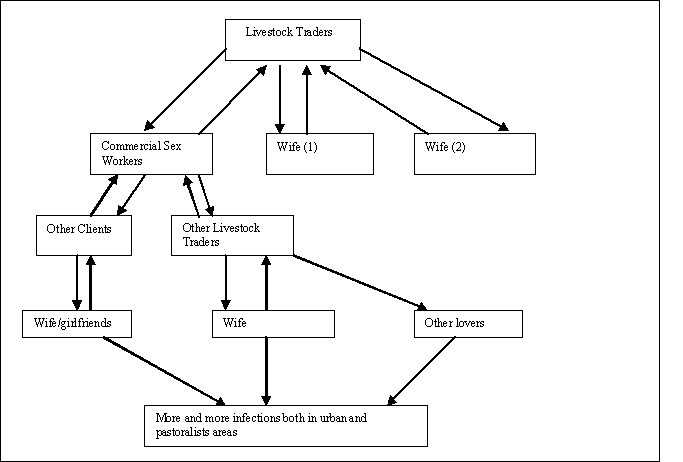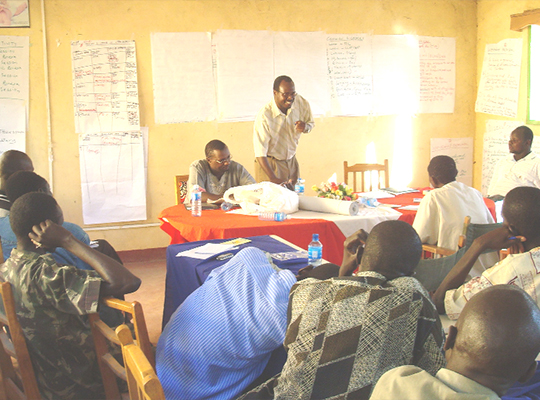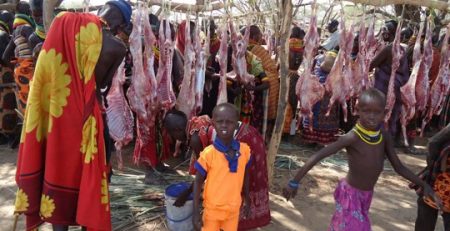District HIV/AID Coordinator explaining the current status on HIV / AID to the DLMC members
HIV/AIDS is one of the devastating catastrophe that has one of the most negative and long lasting impacts on almost all social economic aspects of life and sectors. It has perpetuated poverty, food insecurity, gender disparity and has overwhelmed traditional social support systems.
By the end of 2006, UNAIDS estimated that there were about 39.5 million people globally living with HIV& AIDS (2.6 million more than in 2004). And about 2.9 million died due to AIDS related diseases by the end of 2006. With nearly 90% of the infected being adults in economically productive years, and more than 75% of them living in sub-Sahara Africa, and 52% of the affected being women and girls. Development and social-economic specialists concur that the negative impacts of the HIV& AIDS pandemic will be felt for decades, even if an HIV vaccine or AIDS cure was to be discovered today.
Available data (NACC December 2006) indicate that about 1.3million Kenyans are infected with HIV while about 1.5 million people have died from HIV/AIDS related causes. Although the national prevalence has declined significantly from a peak of about 14% in 2000 to the current 5.9% (NACC Dec, 2006) the cumulative AIDS deaths continue to rise and the impact on society is becoming increasingly severe. The Economic survey report of 2003 indicates that AIDS has greatly affected the workforce. For instance, the formal private sector in Kenya employs 1.1 million people (accounting for 61% of all formal jobs) and has about 112,000 of its employees infected with HIV. 15% of this population require comprehensive care and support services.
Development and social-economic specialists concur that the negative impacts of the HIV/AIDS pandemic will be felt for decades, even if the HIV cure was to be discovered today. Unfortunately, with each person infected with HIV, a family is forever affected particularly the most dependent members –the youngest and the oldest generation. This explains why AIDS is breeding a generation of orphaned and vulnerable children who continue to face the unfair challenges of unmet basic needs during their critical time of development.
In spite of the opportunity organizations have in the workplace to strategically respond to HIV/AIDS prevention, AIDS continues to affect the fundamental rights at work particularly with respect to discrimination and stigmatization against workers living with and affected by HIV/AIDS. It has also led to loss of skilled manpower, institutional memory loss and man-hours due to prolonged illness, increased cost of health care, welfare and funeral expenses. Health care costs for workers living with AIDS are largely shifted to the individuals and their households. In order to support workers living with AIDS, households have to cope with dwindling family resources, disruptions in their livelihood initiatives and limited access to basic human needs such as equal education for children, quality care and support services. The impact will continue to compromise efforts made in sustainable development unless all adapts a strategic response to HIV/AIDS.
PASTORALISTS CHALLENGES IN RELATION TO HIV/AIDS
- Strong cultural practices among the pastoralists are the sanctuary for the spread of HIV/AIDS in the region. Such practices include; polygamy, wife inheritance, wife sharing, unsafe circumcisions and FGM and use of un-sterilized instruments at childbirth, body tattooing and piercing.
- Livestock traders are also considered to be the main players in the spread of HIV/AIDS among the pastoralists. It was noted that when some of this pastoralists sell their livestock in the terminal market in the urban areas, they use the money they earned out of the animal sale to buy local brews and engaging in unprotected sexual relations with high risk groups such as commercial sex workers. This increases the web of infections and transmissions among the pastoralists as shown below.
- Vulnerability to the AIDS infections is accelerated by non-adherence to the principles of human rights and wide spread abuse of women. For pastoralists’ women right to security, freedom from inhuman and degrading treatment, information, education, expression, association are not in existence. This impedes on their ability to gather information on HIV/AIDS and take measures to avoid infections.
- Because of the high level of illiteracy among the pastoralists any issue about HIV/AIDS, which are advertised through mass media, do not reach them because they don’t understand they either don’t the language or no access to the information.
- Poor communication network: The roads in most of the pastoralists’ areas are weather roads whose life depends on the vagaries of weather. The poor infrastructure and poor communication network has cut off the pastoralists from information superhighway. Therefore, there is clear absence of reliable and consistent information on HIV/AIDS for pastoral communities.
- Nomadic nature of pastoralists also hinders them from accessing the few medical centres that are usually located in urban areas.
- High level of poverty in the region has hindered adequate utilization of few facilities available in at medical centres because they are unable to pay for the services.
- Conflict and displacements among the pastoralists’ communities have become the order of the day. Such conflict instigates rural-urban migration and associated exposure to HIV/AIDS. Women are especially very vulnerable to sexual exploitation out of their desperation. Conflict is also associated with rape, impoverishment and a breakdown of social order, which contributes directly to the spread of HIV/AIDS.
- Destitute pastoralists move to urban areas in search for manual jobs. Most of these immigrants live in urban centres alone leaving their wives in their rural homes. In the stint of separation the men occasionally utilize the services of commercial sex workers unprotected, hence they contract HIV/AIDS consequently infecting their wives.
THE HIV/AIDS TRANSMISSIONS WEB AMONG THE PASTORALISTS

Recommendations to the livestock traders made as a way of ensuring HIV/AIDS prevalence/spread is reduced;
- HIV/AIDS awareness creation e.g
- Need of voluntary testing
- Use of condoms
- Being faithful to one partner/spouse
- Stigma reduction
- Circumcision
- Discuss HIV/AIDS in the family
- Provide home based care to the affected persons
- Training other members at the grass root levels
- Collection of data on HIV/AIDS affected and infected persons to the right authorities and stakeholders.
KLMC with the support from OXFAM GB developed a workplace policy.
This HIV/AIDS workplace policy provides an institutional framework for development, implementation and evaluation of comprehensive programs that:
- Creates awareness/education on HIV/AIDS among the staff, management and board;
- Promotes access to HIV/AIDS prevention and behaviour change interventions;
- Protects the rights and dignity of those infected and affected by HIV/AIDS;
- Develops a comprehensive institutional framework to enhance linkages and partnerships to increase access to care and support for workers and their families;
- Provides for dispute resolution mechanisms and;
- Provides M&E guidelines.
The HIV/AIDS workplace policy is not only compliant with The Joint Oxfam HIV/AIDS program strategic priority for East and Central Africa but, it is also in line with the Kenya government’s National AIDS Strategic Plan (KNASP-2005-2010) and the HIV/AIDS Prevention and Control Act 2006. The KNASP calls for multi-sectoral approach that involves civil society and development partners among others to adopt strategic response in the fight against HIV/AIDS, which include workplace policy and mainstreaming of HIV/AIDS to core business.
The policy is also compliant with the Federation of Kenya Employers (FKE) code of conduct on HIV/AIDS in the workplace (revised edition of 2002) and with the International Labour Organization (ILO) codes of practice on HIV/AIDS that promotes protection of the rights and the dignity of workers and persons living with HIV and AIDS (ILO, 1997).



Leave a Reply